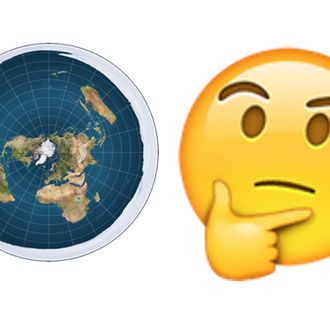Inside ‘Flat Earth,’ Tila Tequila’s New Belief System and the Wokest Conspiracy Theory of 2016

What shape would you say Earth is? A sphere? Ha-ha, nice try. You could not be more wrong. Earth is a disc.
This is according to Tila Tequila, the model, porn star, Juggalette, erstwhile Nazi, and living monument to the ancient lost culture of MySpace.
“But,” you might stammer, “I was always taught that the earth was a sphere.” Oh, yeah? Who are you going to trust? The failing American public-education system or a two-hour documentary posted on YouTube by “Yoda’s Flat Earth Channel”?
The Flat Earth movement — by which I mean the evergreen alternate scientific/conspiracy theory that posits that the earth is a flat disc — has been around since the late 19th century. (A few ancient cultures did indeed assume the world was flat, though it was never as widely held a belief as some later historians would claim.) The first Flat Earthers, and most of their descendants, tended to push the theory as a confirmation of the Bible’s truth; early texts include The Inconsistency of Modern Astronomy and Its Opposition to the Scripture and the proto-listicle One Hundred Proofs That the Earth Is Not a Globe.
The evidence against the flat earth? Physics, photographs from space, the experience of watching a ship meet the horizon. Evidence for a flat earth? Well, you know, everything looks pretty flat. Allow Tila Tequila, the most “friended” person on Myspace v1.0, to explain:
(It’s worth noting that these tweets were sent in the middle of the night, the optimal time to fall down a YouTube k-hole.)
Social-media icon and director of the Hayden Planetarium Neil deGrasse Tyson has not yet responded to Tequila.
The main organization pushing the Flat Earth theory (which is a theory in the same way that gravity is a theory, a.k.a. fact) is the Flat Earth Society, founded in 1956 by a songwriter named Samuel Shenton (who died in 2001) and resurrected in 2004 by Daniel Shenton (apparently no relation).
Here’s what a flat earth looks like:
The earth is in the form of a disk with the North Pole in the center and Antarctica as a wall around the edge. This is the generally accepted model among members of the society. In this model, circumnavigation is performed by moving in a great circle around the North Pole.
The earth is surrounded on all sides by an ice wall that holds the oceans back. This ice wall is what explorers have named Antarctica. Beyond the ice wall is a topic of great interest to the Flat Earth Society. To our knowledge, no one has been very far past the ice wall and returned to tell of their journey. What we do know is that it encircles the earth and serves to hold in our oceans and helps protect us from whatever lies beyond.
Flat Earthers also posit that the sun hovers above our flat earth and “acts like a spotlight and shines downward as it moves,” which explains the day-night cycle.
The theory has had a resurgence in recent months. In a petition on Change.org, the society wrote, “We ask Google to recognise this movement, which has trended over 600% in just the past 12 months, by marking 01/01/2016 as the anniversary of the Flat Earth Movement and changing the Google Doodle image appropriately.” (Their emphasis.)
It’s tough to gauge quite how serious individual Flat Earth believers are about the movement (this post, for example, is not serious). The Twitter account @FlatEarthToday is one of the more active accounts and claims to represent the Flat Earth Society at theflatearthsociety.org. Another account, @FlatEarthOrg, also claims to be the Flat Earth Society, located at tfes.org. Their account only consists of tweets to YouTube videos from conspiracy theorists, and retweets that clearly vary in seriousness, but their site contains a well-maintained explanatory wiki. The line between actually believing the theory and enthusiastically entertaining is unclear.
Being a Flat Earther exists in the same online space as chemtrails and the notion that 9/11 was an inside job: There are some who believe it sincerely, and magnitudes more who entertain the notion ironically. Conspiracy theories are very funny once you lean into them! Imagine finding out that a basic assumption about your life is completely wrong. It’s liberating, in a way. If nothing else, it gives you something to talk about.


